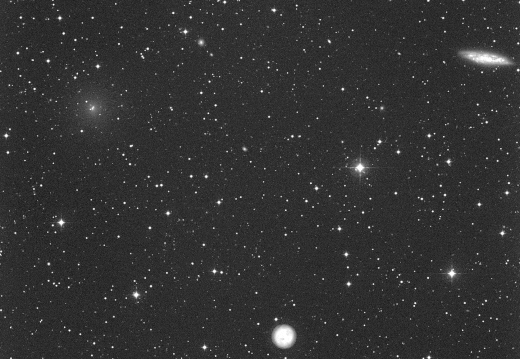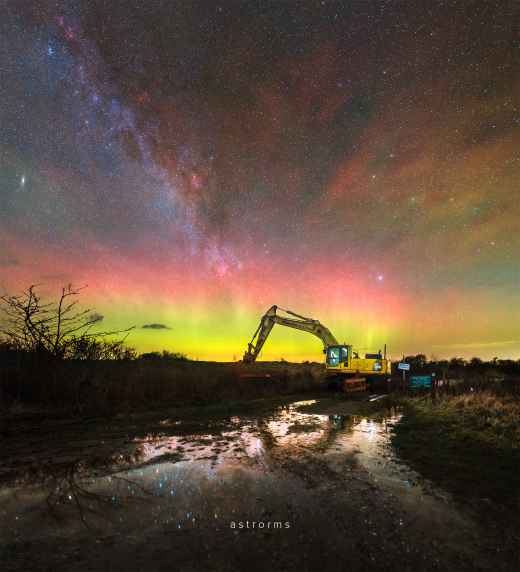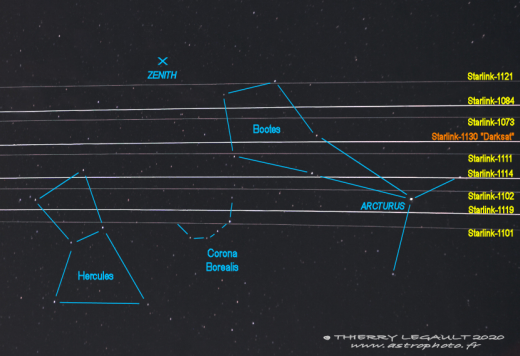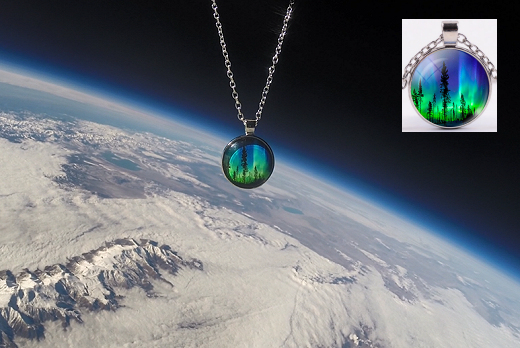Marianne’s Arctic tours: Operating in small groups of 7 to 14 persons--all needs supplied for safety, comfort and pleasure. Night & day photography or non-photographic landscape - wildlife tours. Click for details! | | |
BETELGEUSE IS BRIGHTENING AGAIN: Call off the supernova watch. Betelgeuse is brightening again. Researchers from Villanova University, who have been leading the study of Betelegeuse's unprecedented decline, have confirmed in a new Astronomical Telegram that the star has reversed itself. The turnaround was actually predicted, and suggests the recent dimming was an unusually deep excursion of the star's natural 430-day periodicity. FULL STORY.
COMET ATLAS BUZZES THE OWL NEBULA: Comet ATLAS (C/2019 Y4) is plunging toward the sun for a scorching close encounter at the end of May. First, though, the comet paid a visit to the Owl Nebula (M97). Michael Jäger of Weißenkirchen, Austria, photographed the flyby last night:

The Owl Nebula is the spherical object near the bottom of the image. It is the gaseous shell of an old red giant star more than 2000 light years from Earth. Also shown is the Surfboard Galaxy (M108) in the upper right.
On May 31, 2020, Comet ATLAS will dip inside the orbit of Mercury only 0.25 AU from the sun. ATLAS's orbit is strikingly similar to that of the Great Comet of 1844, which was visible in broad daylight when it passed very close to the sun in the 19th century. Indeed, Comet ATLAS may be a fragment of that Great Comet. Will it too become visible in broad daylight? Or will it evaporate before it gets a chance to really shine? No one knows. Whatever happens, the Heliospheric Imager onboard NASA's STEREO-A spacecraft will be able to record the action. Stay tuned.
Realtime Comet Photo Gallery
Free: Spaceweather.com Newsletter
SQUISH, SQUISH, AURORA BOREALIS: Can auroras make your feet wet? They did Sunday night. Danish photographer Ruslan Merzlyakov almost turned around to drive home on Feb. 23rd when he saw the flooded path to the Uggerby river. "Due to a record amount of rainfall this month, everything was completely flooded," Merzlyakov says. "There was absolutely no sign of the walking path, as it turned into a huge sea stretching towards the beach." But then he noticed a colorful glow on the horizon:

"I decided to photograph the sky despite the wet conditions--and I'm so glad I did," he says. "A 30 second exposure revealed the Milky Way, a dancing band of auroras, and some crazy red airglow as well."
The flooded path turned out to be photogenic, capturing a reflection of the sky overhead. Indeed, it was a good night, after all. The Moon was New, allowing Merzlyakov to see the faint rippling airglow, and a small crack opened in Earth's magnetic field, permitting solar wind to enter and fuel the auroras. Next time, though, Merzlyakov is bringing galoshes.
Realtime Aurora Photo Gallery
Free: Spaceweather.com Newsletter
STARLINK'S DARKSAT IS NOT SO DARK: Last November, SpaceX tried to save astronomy. Among 60 bright and shiny Starlink satellites that blasted off from Cape Canaveral on Nov. 11, 2019, was one "Darksat"--a Starlink satellite with an experimental anti-reflective coating. Making Starlink satellites darker could head off a brewing confrontation between astronomers and internet entrepreneurs.
"But is 'Darksat' really darker?" asks astrophotographer Thierry Legault. "On Saturday morning at astronomical twilight, I filmed the passage of a group of Starlink satellites at their final altitude (550 km). Darksat is one of the brightest."

"On the images covering more than 80° on the sky (from Lyra to Bootes), these satellites reached magnitude 2.5, which is even brighter than I expected! We are still waiting for effective albedo reduction measures, and in the meantime the launches continue..." he says.
Indeed, SpaceX has conducted three more launches since last November, bringing the total number of Starlink satellites in orbit to 300. Ultimately, the network of internet satellites could grow as large as 42,000. That's a lot of artificial stars--and so far the Darksat experiment has not succeeded in reducing their visibility. Keep trying, SpaceX.
Realtime Spaceweather Photo Gallery
Free: Spaceweather.com Newsletter
A GIFT FROM THE EDGE OF SPACE: Every time the students of Earth to Sky Calculus launch cosmic ray sensors to the stratosphere, they send a little something extra along for the ride. For example, this Northern Lights pendant:

On Dec. 6, 2019, it flew 107,612 feet above the rugged Sierra Nevada mountains of central California.
You can have it for $129.95. The students are selling these pendants as a fund-raiser for their cosmic ray monitoring program. They make great anniversary, birthday and Mother's Day gifts. Each pendant comes with a greeting card showing the jewelry in flight and telling the story of its journey to the stratosphere and back again.
Far Out Gifts: Earth to Sky Store
All sales support hands-on STEM education
Every night, a network of
NASA all-sky cameras scans the skies above the United States for meteoritic fireballs. Automated software maintained by NASA's Meteoroid Environment Office calculates their orbits, velocity, penetration depth in Earth's atmosphere and many other characteristics. Daily results are presented here on Spaceweather.com.
On Feb. 25, 2020, the network reported 12 fireballs.
(12 sporadics)

In this diagram of the inner solar system, all of the fireball orbits intersect at a single point--Earth. The orbits are color-coded by velocity, from slow (red) to fast (blue). [Larger image] [movies]
Potentially Hazardous Asteroids (
PHAs) are space rocks larger than approximately 100m that can come closer to Earth than 0.05 AU. None of the known PHAs is on a collision course with our planet, although astronomers are finding
new ones all the time.
On February 25, 2020 there were 2018 potentially hazardous asteroids.
 |
Recent & Upcoming Earth-asteroid encounters: | Asteroid | Date(UT) | Miss Distance | Velocity (km/s) | Diameter (m) |
| 2020 BC9 | 2020-Feb-20 | 13.9 LD | 9.3 | 77 |
| 2020 DE | 2020-Feb-20 | 3.5 LD | 9.7 | 15 |
| 2019 BE5 | 2020-Feb-20 | 13.7 LD | 14.8 | 34 |
| 2020 DC | 2020-Feb-20 | 5.9 LD | 5 | 16 |
| 2020 CP2 | 2020-Feb-20 | 5 LD | 21.1 | 28 |
| 2020 DZ | 2020-Feb-20 | 1.5 LD | 11.2 | 7 |
| 2020 DG1 | 2020-Feb-21 | 13.7 LD | 24 | 44 |
| 2020 DK2 | 2020-Feb-21 | 4 LD | 13.5 | 20 |
| 2020 DJ | 2020-Feb-22 | 9.3 LD | 3.5 | 22 |
| 2020 DR | 2020-Feb-22 | 5.6 LD | 11.4 | 19 |
| 2020 DC1 | 2020-Feb-22 | 13.9 LD | 26.8 | 31 |
| 2020 DB2 | 2020-Feb-22 | 14.5 LD | 20.5 | 35 |
| 2011 DR | 2020-Feb-23 | 14.7 LD | 5.8 | 25 |
| 2016 CO246 | 2020-Feb-23 | 18.4 LD | 5.9 | 25 |
| 2020 CY2 | 2020-Feb-23 | 11.2 LD | 3.8 | 11 |
| 2020 BR10 | 2020-Feb-23 | 15.4 LD | 15.1 | 101 |
| 2020 DW1 | 2020-Feb-23 | 6.8 LD | 7 | 12 |
| 2020 BW13 | 2020-Feb-24 | 9.1 LD | 2.4 | 12 |
| 2020 DT2 | 2020-Feb-25 | 5.2 LD | 11.9 | 11 |
| 2012 DS30 | 2020-Feb-26 | 12.3 LD | 5.4 | 22 |
| 2020 DZ1 | 2020-Feb-27 | 7.4 LD | 14.1 | 58 |
| 2020 DM2 | 2020-Feb-28 | 5.9 LD | 4.9 | 12 |
| 2015 BK509 | 2020-Feb-29 | 18.7 LD | 12.5 | 118 |
| 2020 DV1 | 2020-Feb-29 | 10.5 LD | 15.6 | 52 |
| 2017 BM123 | 2020-Mar-01 | 10.5 LD | 8.1 | 65 |
| 2018 RF6 | 2020-Mar-10 | 11.2 LD | 12.6 | 36 |
| 2020 CA3 | 2020-Mar-10 | 13.8 LD | 6.3 | 30 |
| 2008 UB95 | 2020-Mar-11 | 18.5 LD | 7.6 | 41 |
| 2018 GY | 2020-Mar-15 | 6.2 LD | 9.5 | 39 |
| 2012 XA133 | 2020-Mar-27 | 17.4 LD | 23.7 | 235 |
| 2010 GD35 | 2020-Mar-29 | 15.3 LD | 12 | 43 |
| 2006 FH36 | 2020-Mar-30 | 11.3 LD | 5.1 | 93 |
| 2019 GM1 | 2020-Apr-02 | 9 LD | 4.2 | 14 |
| 2015 FC35 | 2020-Apr-04 | 10.5 LD | 13.8 | 148 |
| 2019 HM | 2020-Apr-10 | 7.2 LD | 3.2 | 23 |
| 363599 | 2020-Apr-11 | 19.2 LD | 24.5 | 224 |
Notes: LD means "Lunar Distance." 1 LD = 384,401 km, the distance between Earth and the Moon. 1 LD also equals 0.00256 AU. MAG is the visual magnitude of the asteroid on the date of closest approach. | | Cosmic Rays in the Atmosphere |
SOMETHING NEW! We have developed a new predictive model of aviation radiation. It's called E-RAD--short for Empirical RADiation model. We are constantly flying radiation sensors onboard airplanes over the US and and around the world, so far collecting more than 22,000 gps-tagged radiation measurements. Using this unique dataset, we can predict the dosage on any flight over the USA with an error no worse than 15%.
E-RAD lets us do something new: Every day we monitor approximately 1400 flights criss-crossing the 10 busiest routes in the continental USA. Typically, this includes more than 80,000 passengers per day. E-RAD calculates the radiation exposure for every single flight.
The Hot Flights Table is a daily summary of these calculations. It shows the 5 charter flights with the highest dose rates; the 5 commercial flights with the highest dose rates; 5 commercial flights with near-average dose rates; and the 5 commercial flights with the lowest dose rates. Passengers typically experience dose rates that are 20 to 70 times higher than natural radiation at sea level.
To measure radiation on airplanes, we use the same sensors we fly to the stratosphere onboard Earth to Sky Calculus cosmic ray balloons: neutron bubble chambers and X-ray/gamma-ray Geiger tubes sensitive to energies between 10 keV and 20 MeV. These energies span the range of medical X-ray machines and airport security scanners.
Column definitions: (1) The flight number; (2) The maximum dose rate during the flight, expressed in units of natural radiation at sea level; (3) The maximum altitude of the plane in feet above sea level; (4) Departure city; (5) Arrival city; (6) Duration of the flight.
SPACE WEATHER BALLOON DATA: Approximately once a week, Spaceweather.com and the students of Earth to Sky Calculus fly space weather balloons to the stratosphere over California. These balloons are equipped with radiation sensors that detect cosmic rays, a surprisingly "down to Earth" form of space weather. Cosmic rays can seed clouds, trigger lightning, and penetrate commercial airplanes. Furthermore, there are studies ( #1, #2, #3, #4) linking cosmic rays with cardiac arrhythmias and sudden cardiac death in the general population. Our latest measurements show that cosmic rays are intensifying, with an increase of more than 18% since 2015:

The data points in the graph above correspond to the peak of the Regener-Pfotzer maximum, which lies about 67,000 feet above central California. When cosmic rays crash into Earth's atmosphere, they produce a spray of secondary particles that is most intense at the entrance to the stratosphere. Physicists Eric Reneger and Georg Pfotzer discovered the maximum using balloons in the 1930s and it is what we are measuring today.
En route to the stratosphere, our sensors also pass through aviation altitudes:

In this plot, dose rates are expessed as multiples of sea level. For instance, we see that boarding a plane that flies at 25,000 feet exposes passengers to dose rates ~10x higher than sea level. At 40,000 feet, the multiplier is closer to 50x.
The radiation sensors onboard our helium balloons detect X-rays and gamma-rays in the energy range 10 keV to 20 MeV. These energies span the range of medical X-ray machines and airport security scanners.
Why are cosmic rays intensifying? The main reason is the sun. Solar storm clouds such as coronal mass ejections (CMEs) sweep aside cosmic rays when they pass by Earth. During Solar Maximum, CMEs are abundant and cosmic rays are held at bay. Now, however, the solar cycle is swinging toward Solar Minimum, allowing cosmic rays to return. Another reason could be the weakening of Earth's magnetic field, which helps protect us from deep-space radiation.
| | The official U.S. government space weather bureau |
| | The first place to look for information about sundogs, pillars, rainbows and related phenomena. |
| | Researchers call it a "Hubble for the sun." SDO is the most advanced solar observatory ever. |
| | 3D views of the sun from NASA's Solar and Terrestrial Relations Observatory |
| | Realtime and archival images of the Sun from SOHO. |
| | from the NOAA Space Environment Center |
| | fun to read, but should be taken with a grain of salt! Forecasts looking ahead more than a few days are often wrong. |
| | from the NOAA Space Environment Center |
| | the underlying science of space weather |
 | To find reviews of new online casino sites in the UK try The Casino DB where there are hundreds of online casino reviews complete with bonuses and ratings. Get a bonus when playing at a new casino in the UK. The Genie got you covered! Looking for a new online casino? Try Casimpo the new site dedicated to making online casino simple and easy for all. |
| | These links help Spaceweather.com stay online. Thank you to our supporters! |
| | | | | | |

